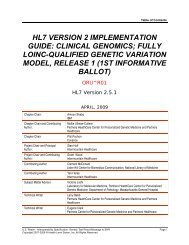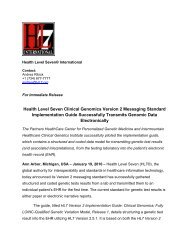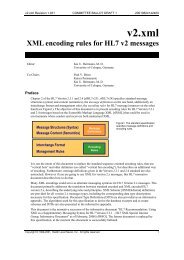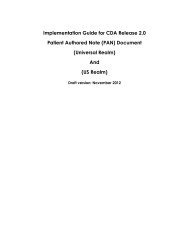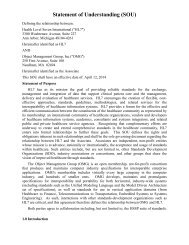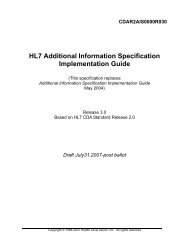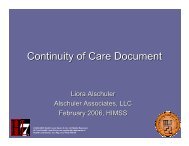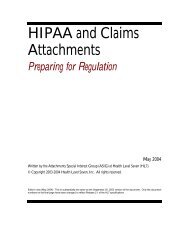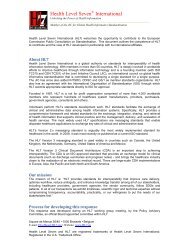Sydney, Australia–Here We Come! - HL7
Sydney, Australia–Here We Come! - HL7
Sydney, Australia–Here We Come! - HL7
You also want an ePaper? Increase the reach of your titles
YUMPU automatically turns print PDFs into web optimized ePapers that Google loves.
Motivation behind the use ofstandardized messagesThe variability of manufacturers of the laboratory informationsystems implemented in Andalusia makes itdifficult for the data architectures of these systems andof the LTM itself to be compatible, thus requiring theuse of standard messages that are understood by all theactors, regardless of their data structures. On anotherhand, the need has arisen to offer standardized externalcommunication in such a way that a standardized routeis established for interoperability with other laboratoryinformation systems that are different from the onesalready implemented.Description of the message sequence appliedThe <strong>HL7</strong> version used in this module is Version 2.5 onXML. The basic interoperability cycle between LTM andthe laboratories, which begins when the samples arecollected, is perfectly defined with a series of events thatsend the messages:1. When health care personnel perform the extraction,the extraction data and the laboratory test requestare sent to the laboratory. The message type definedis ORM^O01.2. Upon the digital arrival of the request, the LTM isinformed that the request has been received correctly.The message type defined is ORR^O02.Figure 3: Usual sequenceSEPTEMBER 20103. When the samples arrive in the laboratory, thecorresponding confirmation message is sent. Themessage type defined is ORM^O01.4. When the results of the tests requested are generatedfrom the sample analyses, the LTM is senta results delivery message (with partial or finalresults). The message type defined is ORU^R01.5. When the results are generated from subsequentrevisions, the LTM is sent a message of the post-finalresults. The message type defined is ORU^R01.Additionally, it is possible to cancel an extraction, as longas the samples have not been received by the laboratory:1. Upon the extraction cancellation, a cancellationrequest is sent to the laboratory. The message typedefined is ORM^O01.2. Upon the arrival of the cancellation, the LTM is informedthat the request has arrived correctly. Themessage type defined is ORR^O02.Difficulties encounteredin the standard’s useThe use of the <strong>HL7</strong> messaging standard for managinglaboratory tests has presented certain difficulties, whichinclude different interpretations of the standard by thedifferent project participants; supporting escape charactersin the communication with laboratory systems; andthe interpretation of the types of data, such as the datetype format.Description of <strong>HL7</strong>’s impact on thedesign of the LTMThe advantages of selecting <strong>HL7</strong> for theinteroperability of the different LTMcomponents may be stated as:• Simplifying the development ofcommunication interfaces betweensubsystems• Respecting the idiosyncrasies of thedifferent systems, maintaining a commoncommunication point• Ensuring its future maintenance:° A technological change that affectsthe architecture or its componentswill not require having to re-integrate the subsystems° A more adequate response isoffered to the increasing demandof information managed by thismodulecontinued on next page19




